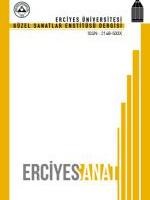SİSTEMLEŞTİRME YÖNTEMLERİ VE ÖNEMLİ TAKSONOMİ KRİTERLERİ
Müzik kültürünün bir olgusu olan çalgıların öğrenimi, çok eski ve uzun bir geçmişe sahiptir. Çalgıların öğrenimiyle gelişerek meydana çıkan organoloji disiplini, sadece yöresel çalgıların öğrenimiyle sınırlı kalmadan giderek dünya çalgılarıyla genişletilir. Organoloji, çalgıların tarihi ve onların çeşitli kültürlerde kullanımı, ses üretiminin teknik yönleri ve sınıflandırılması gibi birçok alanlar içermektedir. Çalgıların akustik özellikleri ve tasarımı ile ilgili problemleri geniş bir yelpazede öğrenen bir bilim olmakla aynı zamanda sosyoloji, etnografya ve tarih ile de yakın bir ilişki kurar. Organoloji hem halk müziğinde, hem de profesyonel orkestralarda kullanılan çalgıların müzikoloji ve orgonografik yöntemlerle geniş bir araştırmasını yaparak tarihsel evrimi, yapısı, akustiği ve sınıflandırması gibi konulara temas eder.
Anahtar Kelimeler:
Çalgı, organoloji, sınıflandırma yöntemleri, taksonomi
-
Musical instruments’ study as a part of music culture has very old and long history. The organology had developed from the study of instruments and didn’t stay in the limits of the traditional instruments, but expanded until the world’s instruments study. The organology includes such areas as the history of the instruments, the various use them in the different cultures, the technical aspects of the sound’s producing and classification. The science, which deals with a wide range of the problems of the acoustic properties of musical instruments and their design, at the same time established a close relationship with the sociology, ethnography and history. The organology, making wide researches of the instruments, used as in folk orchestras and in professional ones, touches such themes as a historical evolution, structure, acoustics and classification of them. Тhe theme of the discussion of this work defined as a multilateral methods of analysis for the study of musical instruments. A problematic issue arises as an absence of significant sources and documents in turkish, related to taxonomic criteria and systematization that are the important parts of organology. By the new researches and translations in this work it is expected to overcome the shortcomings of the students in the study of acoustics, structural features and systematization of musical instruments
Keywords:
Musical instruments, organology, classification method, taxonomy,
___
- AMER, C. (2004).The Facts on File Dictionary of Music. Infobase Publishing.
- BUSH, D. E., KASSEL, R. (2006).The organ: An encyclopedia. New York:London.
- CANDELARİA, CHAVEZ; P. J. GARCÍA ; A. J. ALDAMA. (2004).
- Encyclopedia of Latino Popular Culture, Vol.2. Greenwood Publishing Group. GEVAERT, F. (1885). Nouveau traité d’Instrumentation. (çev. Ars, N. 1913). Paris:
- Paris, Bruxelles, Lemoine & fils. GİSLASON, S. (2011). Sound of Music. Environmed Research Inc.
- HORNBOSTEL, E. V. and C.SACHS. (1961). Classification of Musical Instruments.
- (Translated: Anthony Baines and Klaus P. Wachsmann). The Galpin Society Journal. Vol. USA. JENKINS, J. L. (1960). A New System Of Classıfyıng Musıcal Instruments Used
- In The U.S.S.R. The Galpin Society Journal.Vol. 13, Jul, pp. 95–97 KLAPURİ, A., DAVY, M. (2006). Signal Processing Methods for Music Transcrip- tion. Springer.
- KVİFTE, T., JENSEN, S. (2007). Instruments and the Electronic Age. Oslo: Lulu pres.
- LYSLOFF, R. T. A, J. MATSON. (1985). A New Approach to the Classification of Sound-Producing Instruments. Ethnomusicology. Spring – Summer. Vol. 29, No. 2. pp., 213-236.
- MAYR, E. (1971). “Principi zoologiceskoy sistematiki”, per.s angl, Bolşaya Sovetska- ya Enciklopediya, 1969-1978, 3. izdaniye, Moskva.
- NZEWİ, M., NZEWİ, O. (2007). “A contemporary study of musical arts”. Informed by African indigenous knowledge systems. African Minds.Vol.1. pp.79-82.
- ORLEDGE, R. (1990). Satie the composer. Cambridge University Press.
- PEN, R. (1992). Introduction To Music. McGraw-Hill Professional.
- SİNGH, G. (2004). Plant Systematics: An Integrated Approach, Science Publishers.
- SOKOLOV, G.(2010). “İnstrumenti Udarnoy Ustanovki i İx Castnaya Klassifikaci- ya”. İzvestiya Samarskogo nauchnogo centra Rossiyskoy Akademi Nauk.t12, n13.
- VERTKOV, K., LEVİN, S. (1973). Bolshaya Sovetskaya Enciklopediya. t.26.
- Başlangıç: 2014
- Yayıncı: Erciyes Üniversitesi
Sayıdaki Diğer Makaleler
TÜKETİM TOPLUMUNUN DİNAMİKLERİNE BİR BAKIŞ
SİNEMA VE FOTOĞRAF: DURAĞAN FİLM KARELERİNİN ESTETİĞİ
CENAN AKIN’IN VARYASYON SİLSİLESİ
Özlem DOĞAN, Doç. Afak JAFAROVA
SİSTEMLEŞTİRME YÖNTEMLERİ VE ÖNEMLİ TAKSONOMİ KRİTERLERİ
MAKAMSAL VİYOLONSEL EĞİTİMİ İÇİN E-ÖĞRENME KAPSAMINDA BİR KİTAPLIK ÖNERİSİ: YOUTUBE ÖRNEĞİ
BÜYÜK TÜRK DAHİSİ EMİR HÜSREV VE MÜZİK ALANINDAKİ BAŞARILAR
Fazlı ARSLAN, Ayna İSABABAYEVA
ÇEVREYE GRAFİK TASARIMCI DOKUNUŞU: SOKAK GRAFİKLERİ
KANUN İCRASI TEKNİĞİ BAKIMINDAN EROL DERAN' IN ACEMKÜRDİ MAKAMINDAKİ TAKSİMİ ÜZERİNE BİR ÇALIŞMA
